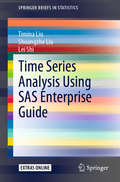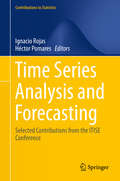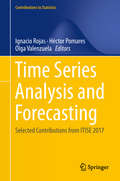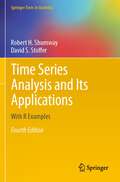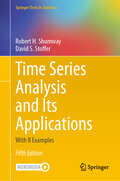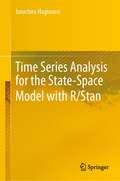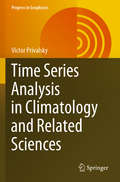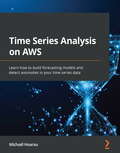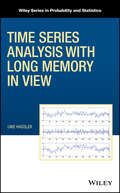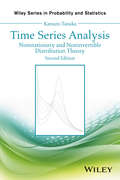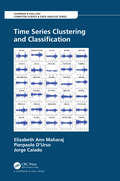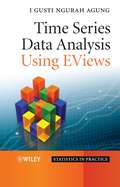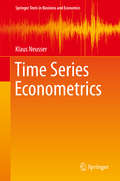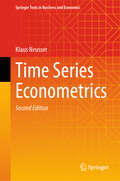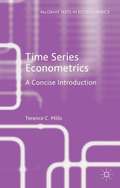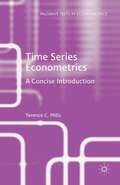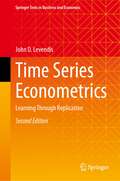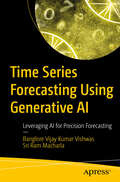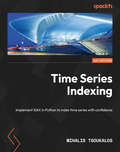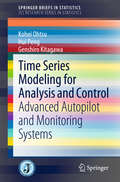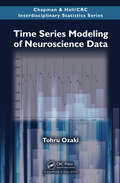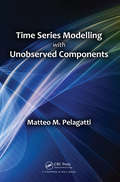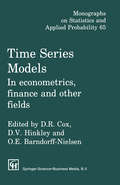- Table View
- List View
Time Series Analysis Using SAS Enterprise Guide (SpringerBriefs in Statistics)
by Timina Liu Shuangzhe Liu Lei ShiThis is the first book to present time series analysis using the SAS Enterprise Guide software. It includes some starting background and theory to various time series analysis techniques, and demonstrates the data analysis process and the final results via step-by-step extensive illustrations of the SAS Enterprise Guide software. This book is a practical guide to time series analyses in SAS Enterprise Guide, and is valuable resource that benefits a wide variety of sectors.
Time Series Analysis and Forecasting
by Ignacio Rojas Héctor PomaresThis volume presents selected peer-reviewed contributions from The International Work-Conference on Time Series, ITISE 2015, held in Granada, Spain, July 1-3, 2015. It discusses topics in time series analysis and forecasting, advanced methods and online learning in time series, high-dimensional and complex/big data time series as well as forecasting in real problems. The International Work-Conferences on Time Series (ITISE) provide a forum for scientists, engineers, educators and students to discuss the latest ideas and implementations in the foundations, theory, models and applications in the field of time series analysis and forecasting. It focuses on interdisciplinary and multidisciplinary research encompassing the disciplines of computer science, mathematics, statistics and econometrics.
Time Series Analysis and Forecasting: Selected Contributions From The Itise Conference (Contributions To Statistics Ser. #0)
by Ignacio Rojas Héctor Pomares Olga ValenzuelaThis book presents selected peer-reviewed contributions from the International Work-Conference on Time Series, ITISE 2017, held in Granada, Spain, September 18-20, 2017. It discusses topics in time series analysis and forecasting, including advanced mathematical methodology, computational intelligence methods for time series, dimensionality reduction and similarity measures, econometric models, energy time series forecasting, forecasting in real problems, online learning in time series as well as high-dimensional and complex/big data time series.The series of ITISE conferences provides a forum for scientists, engineers, educators and students to discuss the latest ideas and implementations in the foundations, theory, models and applications in the field of time series analysis and forecasting. It focuses on interdisciplinary and multidisciplinary research encompassing computer science, mathematics, statistics and econometrics.
Time Series Analysis and Its Applications: With R Examples (Springer Texts in Statistics)
by Robert H. Shumway David S. StofferThe fourth edition of this popular graduate textbook, like its predecessors, presents a balanced and comprehensive treatment of both time and frequency domain methods with accompanying theory. Numerous examples using nontrivial data illustrate solutions to problems such as discovering natural and anthropogenic climate change, evaluating pain perception experiments using functional magnetic resonance imaging, and monitoring a nuclear test ban treaty.The book is designed as a textbook for graduate level students in the physical, biological, and social sciences and as a graduate level text in statistics. Some parts may also serve as an undergraduate introductory course. Theory and methodology are separated to allow presentations on different levels. In addition to coverage of classical methods of time series regression, ARIMA models, spectral analysis and state-space models, the text includes modern developments including categorical time series analysis, multivariate spectral methods, long memory series, nonlinear models, resampling techniques, GARCH models, ARMAX models, stochastic volatility, wavelets, and Markov chain Monte Carlo integration methods.This edition includes R code for each numerical example in addition to Appendix R, which provides a reference for the data sets and R scripts used in the text in addition to a tutorial on basic R commands and R time series. An additional file is available on the book’s website for download, making all the data sets and scripts easy to load into R.
Time Series Analysis and Its Applications: With R Examples (Springer Texts in Statistics)
by Robert H. Shumway David S. StofferThis 5th edition of this popular graduate textbook presents a balanced and comprehensive treatment of both time and frequency domain methods with accompanying theory. It includes numerous examples using nontrivial data illustrate solutions to problems such as discovering natural and anthropogenic climate change, evaluating pain perception experiments using functional magnetic resonance imaging, and monitoring a nuclear test ban treaty. The R package ‘astsa’ has had major updates and the text will reflect those updates. In general, the graphics have been improved. New topics include random number generation, modeling and fitting predator-prey interactions, more emphasis on structural models, testing for linearity, discussion of EM algorithm is more extensive, Bayesian analysis of state space models and MCMC is more extensive (including new scripts in astsa), particle methods are introduced, stochastic volatility coverage is expanded, changepoint detection is introduced (new topic). The book is designed as a textbook for graduate level students in the physical, biological, and social sciences and as a graduate level text in statistics. Some parts may also serve as an undergraduate introductory course. Theory and methodology are separated to allow presentations on different levels. In addition to coverage of classical methods of time series regression, ARIMA models, spectral analysis and state-space models, the text includes modern developments including categorical time series analysis, multivariate spectral methods, long memory series, nonlinear models, resampling techniques, GARCH models, ARMAX models, stochastic volatility, and Markov chain Monte Carlo integration methods. This edition includes R code for each numerical example.
Time Series Analysis for the Social Sciences
by Janet M. Box-steffensmeier John R. Freeman Matthew P. Hitt Jon C. W. PevehouseTime series, or longitudinal, data are ubiquitous in the social sciences. Unfortunately, analysts often treat the time series properties of their data as a nuisance rather than a substantively meaningful dynamic process to be modeled and interpreted. Time Series Analysis for the Social Sciences provides accessible, up-to-date instruction and examples of the core methods in time series econometrics. Janet M. Box-Steffensmeier, John R. Freeman, Jon C. Pevehouse and Matthew P. Hitt cover a wide range of topics including ARIMA models, time series regression, unit-root diagnosis, vector autoregressive models, error-correction models, intervention models, fractional integration, ARCH models, structural breaks, and forecasting. This book is aimed at researchers and graduate students who have taken at least one course in multivariate regression. Examples are drawn from several areas of social science, including political behavior, elections, international conflict, criminology, and comparative political economy.
Time Series Analysis for the State-Space Model with R/Stan
by Junichiro HagiwaraThis book provides a comprehensive and concrete illustration of time series analysis focusing on the state-space model, which has recently attracted increasing attention in a broad range of fields. The major feature of the book lies in its consistent Bayesian treatment regarding whole combinations of batch and sequential solutions for linear Gaussian and general state-space models: MCMC and Kalman/particle filter. The reader is given insight on flexible modeling in modern time series analysis. The main topics of the book deal with the state-space model, covering extensively, from introductory and exploratory methods to the latest advanced topics such as real-time structural change detection. Additionally, a practical exercise using R/Stan based on real data promotes understanding and enhances the reader’s analytical capability.
Time Series Analysis in Climatology and Related Sciences (Progress in Geophysics)
by Victor PrivalskyThis book gives the reader the basic knowledge of the theory of random processes necessary for applying to study climatic time series. It contains many examples in different areas of time series analysis such as autoregressive modelling and spectral analysis, linear extrapolation, simulation, causality, relations between scalar components of multivariate time series, and reconstructions of climate data. As an important feature, the book contains many practical examples and recommendations about how to deal and how not to deal with applied problems of time series analysis in climatology or any other science where the time series are short.
Time Series Analysis on AWS: Learn how to build forecasting models and detect anomalies in your time series data
by Michael HoarauLeverage AWS AI/ML managed services to generate value from your time series dataKey FeaturesSolve modern time series analysis problems such as forecasting and anomaly detectionGain a solid understanding of AWS AI/ML managed services and apply them to your business problemsExplore different algorithms to build applications that leverage time series dataBook DescriptionBeing a business analyst and data scientist, you have to use many algorithms and approaches to prepare, process, and build ML-based applications by leveraging time series data, but you face common problems, such as not knowing which algorithm to choose or how to combine and interpret them. Amazon Web Services (AWS) provides numerous services to help you build applications fueled by artificial intelligence (AI) capabilities. This book helps you get to grips with three AWS AI/ML-managed services to enable you to deliver your desired business outcomes.The book begins with Amazon Forecast, where you'll discover how to use time series forecasting, leveraging sophisticated statistical and machine learning algorithms to deliver business outcomes accurately. You'll then learn to use Amazon Lookout for Equipment to build multivariate time series anomaly detection models geared toward industrial equipment and understand how it provides valuable insights to reinforce teams focused on predictive maintenance and predictive quality use cases. In the last chapters, you'll explore Amazon Lookout for Metrics, and automatically detect and diagnose outliers in your business and operational data.By the end of this AWS book, you'll have understood how to use the three AWS AI services effectively to perform time series analysis.What you will learnUnderstand how time series data differs from other types of dataExplore the key challenges that can be solved using time series dataForecast future values of business metrics using Amazon ForecastDetect anomalies and deliver forewarnings using Lookout for EquipmentDetect anomalies in business metrics using Amazon Lookout for MetricsVisualize your predictions to reduce the time to extract insightsWho this book is forIf you're a data analyst, business analyst, or data scientist looking to analyze time series data effectively for solving business problems, this is the book for you. Basic statistics knowledge is assumed, but no machine learning knowledge is necessary. Prior experience with time series data and how it relates to various business problems will help you get the most out of this book. This guide will also help machine learning practitioners find new ways to leverage their skills to build effective time series-based applications.
Time Series Analysis with Long Memory in View (Wiley Series in Probability and Statistics #215)
by Uwe HasslerProvides a simple exposition of the basic time series material, and insights into underlying technical aspects and methods of proof Long memory time series are characterized by a strong dependence between distant events. This book introduces readers to the theory and foundations of univariate time series analysis with a focus on long memory and fractional integration, which are embedded into the general framework. It presents the general theory of time series, including some issues that are not treated in other books on time series, such as ergodicity, persistence versus memory, asymptotic properties of the periodogram, and Whittle estimation. Further chapters address the general functional central limit theory, parametric and semiparametric estimation of the long memory parameter, and locally optimal tests. Intuitive and easy to read, Time Series Analysis with Long Memory in View offers chapters that cover: Stationary Processes; Moving Averages and Linear Processes; Frequency Domain Analysis; Differencing and Integration; Fractionally Integrated Processes; Sample Means; Parametric Estimators; Semiparametric Estimators; and Testing. It also discusses further topics. This book: Offers beginning-of-chapter examples as well as end-of-chapter technical arguments and proofs Contains many new results on long memory processes which have not appeared in previous and existing textbooks Takes a basic mathematics (Calculus) approach to the topic of time series analysis with long memory Contains 25 illustrative figures as well as lists of notations and acronyms Time Series Analysis with Long Memory in View is an ideal text for first year PhD students, researchers, and practitioners in statistics, econometrics, and any application area that uses time series over a long period. It would also benefit researchers, undergraduates, and practitioners in those areas who require a rigorous introduction to time series analysis.
Time Series Analysis: Nonstationary and Noninvertible Distribution Theory
by Katsuto TanakaReflects the developments and new directions in the field since the publication of the first successful edition and contains a complete set of problems and solutions This revised and expanded edition reflects the developments and new directions in the field since the publication of the first edition. In particular, sections on nonstationary panel data analysis and a discussion on the distinction between deterministic and stochastic trends have been added. Three new chapters on long-memory discrete-time and continuous-time processes have also been created, whereas some chapters have been merged and some sections deleted. The first eleven chapters of the first edition have been compressed into ten chapters, with a chapter on nonstationary panel added and located under Part I: Analysis of Non-fractional Time Series. Chapters 12 to 14 have been newly written under Part II: Analysis of Fractional Time Series. Chapter 12 discusses the basic theory of long-memory processes by introducing ARFIMA models and the fractional Brownian motion (fBm). Chapter 13 is concerned with the computation of distributions of quadratic functionals of the fBm and its ratio. Next, Chapter 14 introduces the fractional Ornstein–Uhlenbeck process, on which the statistical inference is discussed. Finally, Chapter 15 gives a complete set of solutions to problems posed at the end of most sections. This new edition features: • Sections to discuss nonstationary panel data analysis, the problem of differentiating between deterministic and stochastic trends, and nonstationary processes of local deviations from a unit root • Consideration of the maximum likelihood estimator of the drift parameter, as well as asymptotics as the sampling span increases • Discussions on not only nonstationary but also noninvertible time series from a theoretical viewpoint • New topics such as the computation of limiting local powers of panel unit root tests, the derivation of the fractional unit root distribution, and unit root tests under the fBm error Time Series Analysis: Nonstationary and Noninvertible Distribution Theory, Second Edition, is a reference for graduate students in econometrics or time series analysis. Katsuto Tanaka, PhD, is a professor in the Faculty of Economics at Gakushuin University and was previously a professor at Hitotsubashi University. He is a recipient of the Tjalling C. Koopmans Econometric Theory Prize (1996), the Japan Statistical Society Prize (1998), and the Econometric Theory Award (1999). Aside from the first edition of Time Series Analysis (Wiley, 1996), Dr. Tanaka had published five econometrics and statistics books in Japanese.
Time Series Clustering and Classification (Chapman & Hall/CRC Computer Science & Data Analysis)
by Elizabeth Ann Maharaj Pierpaolo D'Urso Jorge CaiadoThe beginning of the age of artificial intelligence and machine learning has created new challenges and opportunities for data analysts, statisticians, mathematicians, econometricians, computer scientists and many others. At the root of these techniques are algorithms and methods for clustering and classifying different types of large datasets, including time series data. Time Series Clustering and Classification includes relevant developments on observation-based, feature-based and model-based traditional and fuzzy clustering methods, feature-based and model-based classification methods, and machine learning methods. It presents a broad and self-contained overview of techniques for both researchers and students. Features Provides an overview of the methods and applications of pattern recognition of time series Covers a wide range of techniques, including unsupervised and supervised approaches Includes a range of real examples from medicine, finance, environmental science, and more R and MATLAB code, and relevant data sets are available on a supplementary website
Time Series Data Analysis Using EViews: Forecasting Using Eviews
by I. Gusti AgungDo you want to recognize the most suitable models for analysis of statistical data sets? This book provides a hands-on practical guide to using the most suitable models for analysis of statistical data sets using EViews - an interactive Windows-based computer software program for sophisticated data analysis, regression, and forecasting - to define and test statistical hypotheses. Rich in examples and with an emphasis on how to develop acceptable statistical models, Time Series Data Analysis Using EViews is a perfect complement to theoretical books presenting statistical or econometric models for time series data. The procedures introduced are easily extendible to cross-section data sets. The author: Provides step-by-step directions on how to apply EViews software to time series data analysis Offers guidance on how to develop and evaluate alternative empirical models, permitting the most appropriate to be selected without the need for computational formulae Examines a variety of times series models, including continuous growth, discontinuous growth, seemingly causal, regression, ARCH, and GARCH as well as a general form of nonlinear time series and nonparametric models Gives over 250 illustrative examples and notes based on the author's own empirical findings, allowing the advantages and limitations of each model to be understood Describes the theory behind the models in comprehensive appendices Provides supplementary information and data sets An essential tool for advanced undergraduate and graduate students taking finance or econometrics courses. Statistics, life sciences, and social science students, as well as applied researchers, will also find this book an invaluable resource.
Time Series Econometrics
by Klaus NeusserThis text presents modern developments in time series analysis and focuses on their application to economic problems. The book first introduces the fundamental concept of a stationary time series and the basic properties of covariance, investigating the structure and estimation of autoregressive-moving average (ARMA) models and their relations to the covariance structure. The book then moves on to non-stationary time series, highlighting its consequences for modeling and forecasting and presenting standard statistical tests and regressions. Next, the text discusses volatility models and their applications in the analysis of financial market data, focusing on generalized autoregressive conditional heteroskedastic (GARCH) models. The second part of the text devoted to multivariate processes, such as vector autoregressive (VAR) models and structural vector autoregressive (SVAR) models, which have become the main tools in empirical macroeconomics. The text concludes with a discussion of co-integrated models and the Kalman Filter, which is being used with increasing frequency. Mathematically rigorous, yet application-oriented, this self-contained text will help students develop a deeper understanding of theory and better command of the models that are vital to the field. Assuming a basic knowledge of statistics and/or econometrics, this text is best suited for advanced undergraduate and beginning graduate students.
Time Series Econometrics (Springer Texts in Business and Economics)
by Klaus NeusserThis text presents modern developments in time series analysis and focuses on their application to economic problems. The book first introduces the fundamental concept of a stationary time series and its relation to the basic properties of covariance funtions, investigating the structure and estimation of autoregressive-moving average (ARMA) models and their relations to the covariance structure. The book then moves on to non-stationary time series, highlighting its consequences for modeling and forecasting as well as regressions models and presenting standard statistical tests. Next, the text discusses volatility models and their applications in the analysis of financial market data, focusing on generalized autoregressive conditional heteroskedastic (GARCH) models. The second part of the text is devoted to multivariate processes, such as vector autoregressive (VAR) models and structural vector autoregressive (SVAR) models, which have become the main tools in empirical macroeconomics. The text concludes with a discussion of co-integrated models and the Kalman Filter, which is being used with increasing frequency. The exposition finally connects to recent developments in the field. Mathematically rigorous, yet application-oriented, this self-contained text will help students develop a deeper understanding of theory and better command of the models that are vital to the field. Assuming a basic knowledge of statistics and/or econometrics, this text is best suited for advanced undergraduate and beginning graduate students.
Time Series Econometrics: A Concise Introduction (Critical Concepts In Economics)
by Terence C. MillsTime Series Econometrics.
Time Series Econometrics: A Concise Introduction (Palgrave Texts in Econometrics)
by Terence C. MillsThis book provides an introductory treatment of time series econometrics, a subject that is of key importance to both students and practitioners of economics. It contains material that any serious student of economics and finance should be acquainted with if they are seeking to gain an understanding of a real functioning economy.
Time Series Econometrics: Learning Through Replication (Springer Texts in Business and Economics)
by John D. LevendisRevised and updated for the second edition, this textbook allows students to work through classic texts in economics and finance, using the original data and replicating their results. In this book, the author rejects the theorem-proof approach as much as possible, and emphasizes the practical application of econometrics. They show with examples how to calculate and interpret the numerical results.This book begins with students estimating simple univariate models, in a step by step fashion, using the popular Stata software system. Students then test for stationarity, while replicating the actual results from hugely influential papers such as those by Granger & Newbold, and Nelson & Plosser. Readers will learn about structural breaks by replicating papers by Perron, and Zivot & Andrews. They then turn to models of conditional volatility, replicating papers by Bollerslev. Students estimate multi-equation models such as vector autoregressions and vector error-correction mechanisms, replicating the results in influential papers by Sims and Granger. Finally, students estimate static and dynamic panel data models, replicating papers by Thompson, and Arellano & Bond.The book contains many worked-out examples, and many data-driven exercises. While intended primarily for graduate students and advanced undergraduates, practitioners will also find the book useful.“How to best start learning time series econometrics? Learning by doing. This is the ethos of this book. What makes this book useful is that it provides numerous worked out examples along with basic concepts. It is a fresh, no-nonsense, practical approach that students will love when they start learning time series econometrics. I recommend this book strongly as a study guide for students who look for hands-on learning experience."--Professor Sokbae "Simon" Lee, Columbia University, Co-Editor of Econometric Theory and Associate Editor of Econometrics Journal.
Time Series Forecasting Using Generative AI: Leveraging AI for Precision Forecasting
by Banglore Vijay Vishwas Sri Ram Macharla"Time Series Forecasting Using Generative AI introduces readers to Generative Artificial Intelligence (Gen AI) in time series analysis, offering an essential exploration of cutting-edge forecasting methodologies." The book covers a wide range of topics, starting with an overview of Generative AI, where readers gain insights into the history and fundamentals of Gen AI with a brief introduction to large language models. The subsequent chapter explains practical applications, guiding readers through the implementation of diverse neural network architectures for time series analysis such as Multi-Layer Perceptrons (MLP), WaveNet, Temporal Convolutional Network (TCN), Bidirectional Temporal Convolutional Network (BiTCN), Recurrent Neural Networks (RNN), Long Short-Term Memory (LSTM), Deep AutoRegressive(DeepAR), and Neural Basis Expansion Analysis(NBEATS) using modern tools. Building on this foundation, the book introduces the power of Transformer architecture, exploring its variants such as Vanilla Transformers, Inverted Transformer (iTransformer), DLinear, NLinear, and Patch Time Series Transformer (PatchTST). Finally, The book delves into foundation models such as Time-LLM, Chronos, TimeGPT, Moirai, and TimesFM enabling readers to implement sophisticated forecasting models tailored to their specific needs. This book empowers readers with the knowledge and skills needed to leverage Gen AI for accurate and efficient time series forecasting. By providing a detailed exploration of advanced forecasting models and methodologies, this book enables practitioners to make informed decisions and drive business growth through data-driven insights. ● Understand the core history and applications of Gen AI and its potential to revolutionize time series forecasting. ● Learn to implement different neural network architectures such as MLP, WaveNet, TCN, BiTCN, RNN, LSTM, DeepAR, and NBEATS for time series forecasting. ● Discover the potential of Transformer architecture and its variants, such as Vanilla Transformers, iTransformer, DLinear, NLinear, and PatchTST, for time series forecasting. <span sty
Time Series Indexing: Implement iSAX in Python to index time series with confidence
by Mihalis TsoukalosBuild and use the most popular time series index available today with Python to search and join time series at the subsequence level Purchase of the print or Kindle book includes a free PDF eBook.Key FeaturesLearn how to implement algorithms and techniques from research papersGet to grips with building time series indexes using iSAXLeverage iSAX to solve real-world time series problemsBook DescriptionTime series are everywhere, ranging from financial data and system metrics to weather stations and medical records. Being able to access, search, and compare time series data quickly is essential, and this comprehensive guide enables you to do just that by helping you explore SAX representation and the most effective time series index, iSAX. The book begins by teaching you about the implementation of SAX representation in Python as well as the iSAX index, along with the required theory sourced from academic research papers. The chapters are filled with figures and plots to help you follow the presented topics and understand key concepts easily. But what makes this book really great is that it contains the right amount of knowledge about time series indexing using the right amount of theory and practice so that you can work with time series and develop time series indexes successfully. Additionally, the presented code can be easily ported to any other modern programming language, such as Swift, Java, C, C++, Ruby, Kotlin, Go, Rust, and JavaScript. By the end of this book, you'll have learned how to harness the power of iSAX and SAX representation to efficiently index and analyze time series data and will be equipped to develop your own time series indexes and effectively work with time series data.What you will learnFind out how to develop your own Python packages and write simple Python testsUnderstand what a time series index is and why it is usefulGain a theoretical and practical understanding of operating and creating time series indexesDiscover how to use SAX representation and the iSAX indexFind out how to search and compare time seriesUtilize iSAX visualizations to aid in the interpretation of complex or large time seriesWho this book is forThis book is for practitioners, university students working with time series, researchers, and anyone looking to learn more about time series. Basic knowledge of UNIX, Linux, and Python and an understanding of basic programming concepts are needed to grasp the topics in this book. This book will also be handy for people who want to learn how to read research papers, learn from them, and implement their algorithms.
Time Series Modeling for Analysis and Control
by Genshiro Kitagawa Kohei Ohtsu Hui PengThis book presents multivariate time series methods for the analysis and optimal control of feedback systems. Although ships' autopilot systems are considered through the entire book, the methods set forth in this book can be applied to many other complicated, large, or noisy feedback control systems for which it is difficult to derive a model of the entire system based on theory in that subject area. The basic models used in this method are the multivariate autoregressive model with exogenous variables (ARX) model and the radial bases function net-type coefficients ARX model. The noise contribution analysis can then be performed through the estimated autoregressive (AR) model and various types of autopilot systems can be designed through the state-space representation of the models. The marine autopilot systems addressed in this book include optimal controllers for course-keeping motion, rolling reduction controllers with rudder motion, engine governor controllers, noise adaptive autopilots, route-tracking controllers by direct steering, and the reference course-setting approach. The methods presented here are exemplified with real data analysis and experiments on real ships. This book is highly recommended to readers who are interested in designing optimal or adaptive controllers not only of ships but also of any other complicated systems under noisy disturbance conditions.
Time Series Modeling of Neuroscience Data (Chapman & Hall/CRC Interdisciplinary Statistics)
by Tohru OzakiRecent advances in brain science measurement technology have given researchers access to very large-scale time series data such as EEG/MEG data (20 to 100 dimensional) and fMRI (140,000 dimensional) data. To analyze such massive data, efficient computational and statistical methods are required.Time Series Modeling of Neuroscience Data shows how to
Time Series Modelling with Unobserved Components
by Matteo M. PelagattiDespite the unobserved components model (UCM) having many advantages over more popular forecasting techniques based on regression analysis, exponential smoothing, and ARIMA, the UCM is not well known among practitioners outside the academic community. Time Series Modelling with Unobserved Components rectifies this deficiency by giving a practical o
Time Series Models
by Philip Hans FransesThis book considers periodic time series models for seasonal data, characterized by parameters that differ across the seasons, and focuses on their usefulness for out-of-sample forecasting. Providing an up-to-date survey of the recent developments in periodic time series, the book presents a large number of empirical results. The first part of the book deals with model selection, diagnostic checking and forecasting of univariate periodic autoregressive models. Tests for periodic integration, are discussed, and an extensive discussion of the role of deterministic regressors in testing for periodic integration and in forecasting is provided. The second part discusses multivariate periodic autoregressive models. It provides an overview of periodic cointegration models, as these are the most relevant. This overview contains single-equation type tests and a full-system approach based on generalized method of moments. All methods are illustrated with extensive examples, andthe book will be of interest to advanced graduate students and researchers in econometrics, as well as practitioners looking for an understanding of how to approach seasonal data.
Time Series Models: In econometrics, finance and other fields (Chapman And Hall/crc Monographs On Statistics And Applied Probability Ser. #65)
by D.R.Cox; D.V. Hinkley; O.E. Barndorff-NielsenThe analysis prediction and interpolation of economic and other time series has a long history and many applications. Major new developments are taking place, driven partly by the need to analyze financial data. The five papers in this book describe those new developments from various viewpoints and are intended to be an introduction accessible to readers from a range of backgrounds.The book arises out of the second Seminaire European de Statistique (SEMSTAT) held in Oxford in December 1994. This brought together young statisticians from across Europe, and a series of introductory lectures were given on topics at the forefront of current research activity. The lectures form the basis for the five papers contained in the book.The papers by Shephard and Johansen deal respectively with time series models for volatility, i.e. variance heterogeneity, and with cointegration. Clements and Hendry analyze the nature of prediction errors. A complementary review paper by Laird gives a biometrical view of the analysis of short time series. Finally Astrup and Nielsen give a mathematical introduction to the study of option pricing. Whilst the book draws its primary motivation from financial series and from multivariate econometric modelling, the applications are potentially much broader.
